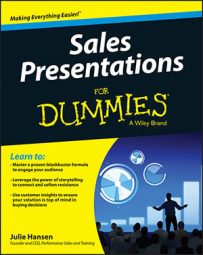In a perfect world you’d have weeks to prepare for every sales presentation, but you don’t live in a perfect world. Opportunities can present themselves with little or no notice. Following are ten things you can do right now that will have a big impact on the success of your presentation.
Know your first line. Nerves and last minute changes can easily throw you off track. If you have your first line down cold, you can start with confidence. After you get that first line out, your preparation will kick in and you’ll be in the flow.
Keep it conversational. Even though you may be doing most of the talking, a sales presentation isn’t a completely one-sided exchange. Leave space for your prospect to respond both verbally and nonverbally. Avoid falling into presenter-mode — a rote-style delivery that causes your prospect to tune out — by keeping your tone conversational but professional.
Interact early. Having your prospect involved in your presentation increases her engagement, makes her more receptive to your message, and improves recall. But don’t wait until the end when it’s too late. Establish the rules early by creating some interaction — such as a question or a poll — in the first few minutes of your presentation.
Keep your prospect focused. Always try and look at things from your prospect’s perspective. From the words you choose to the length of time you spend on any particular subject, put yourself in the shoes of your prospect and ask yourself: “Why should I care about this?
Address the elephant in the room. If you know that you’re going to encounter an obvious obstacle in your presentation — such as a prospect who prefers another vendor or a previous bad experience with your company — you must recognize it in order to open your prospect’s mind to your presentation. Ignoring an elephant is rarely a winning strategy. Acknowledge the obstacle early on, through humor (carefully) or with a well-crafted story or analogy, and then move on.
Get to the good stuff fast. Television networks know that you need to give your audience a glimpse of what they came to see early on in order to keep them engaged. Use that same mind-set in your presentation and give your prospect something they came to see — a benefit, an insight, a discovery — before they’re tempted to take a commercial break.
Use an analogy or metaphor. An analogy or metaphor — popular literal devices used to compare one or more things to something else — are powerful and underutilized tools for helping your prospect understand a complex process or recognize its value or application. Painting a picture in your prospect’s mind makes it easier for her to recall it as well.
Introduce the unexpected. In a sea of familiarity, the unexpected stands out and demands attention. That’s part of the reason shows like Netflix’ House of Cards or AMC’s Breaking Bad are so popular. Unusual comparisons or contradictions can wake up your prospect and draw her in. It shows her that you aren’t just like everyone else and encourages her to pay attention.
Rehearse like a pro. Most people aren’t naturally great performers. From Daniel Radcliffe to Steve Jobs, many people who appeared effortless in their roles put in hundreds of hours of rehearsal time. Although you don’t have that kind of time, plan on spending at least 20 percent of the time you do have rehearsing your presentation, especially focusing on key elements, such as your opening, stories, and your closing. Doing so gives you confidence and frees you up in the moment to place your attention on connecting and engaging with your prospect.
Sell the next minute. Your prospect’s attention is fleeting. Focusing on selling your prospect on staying tuned for the next minute of your presentation — one minute at a time — forces you to make the current minute as compelling as possible.

